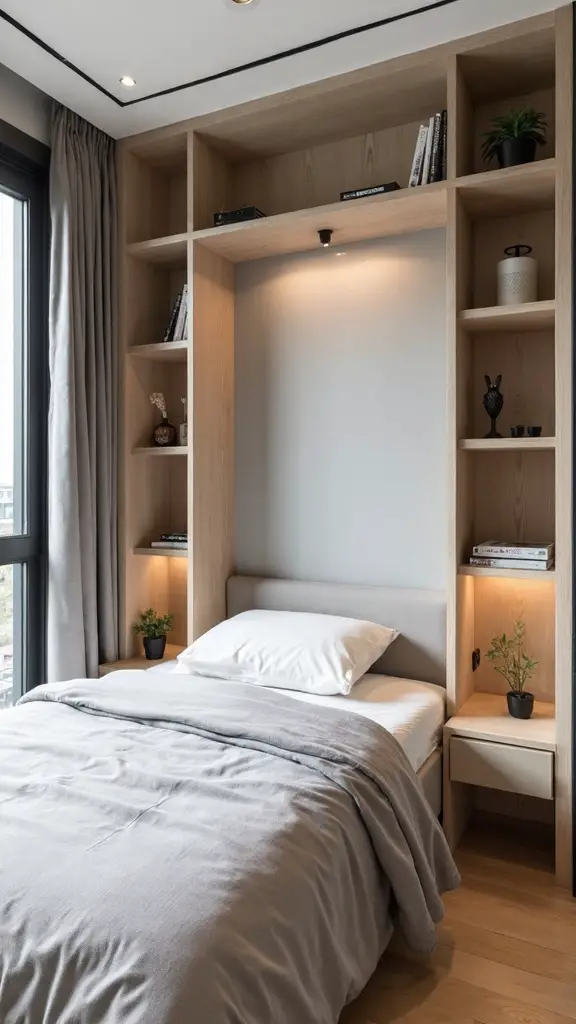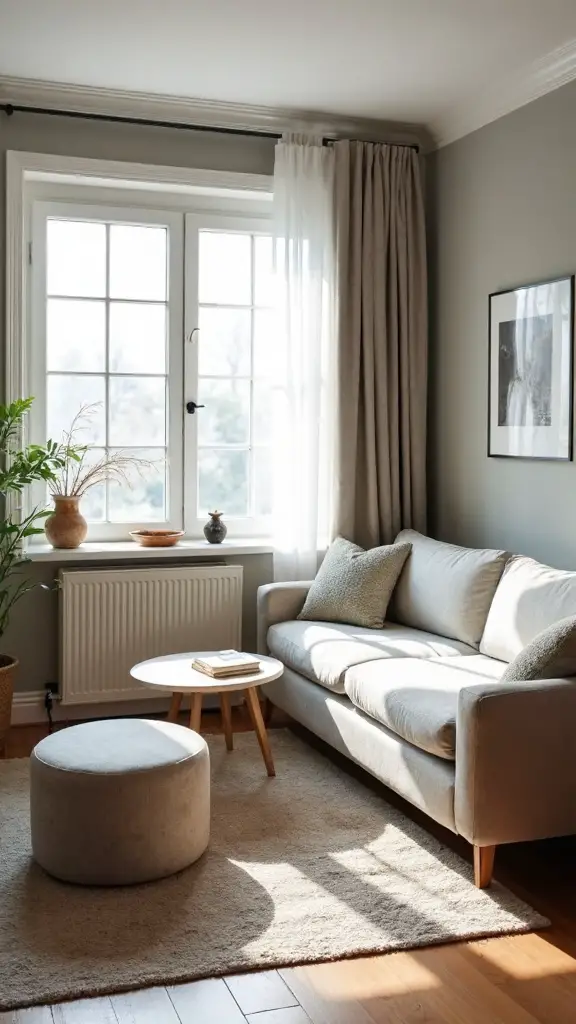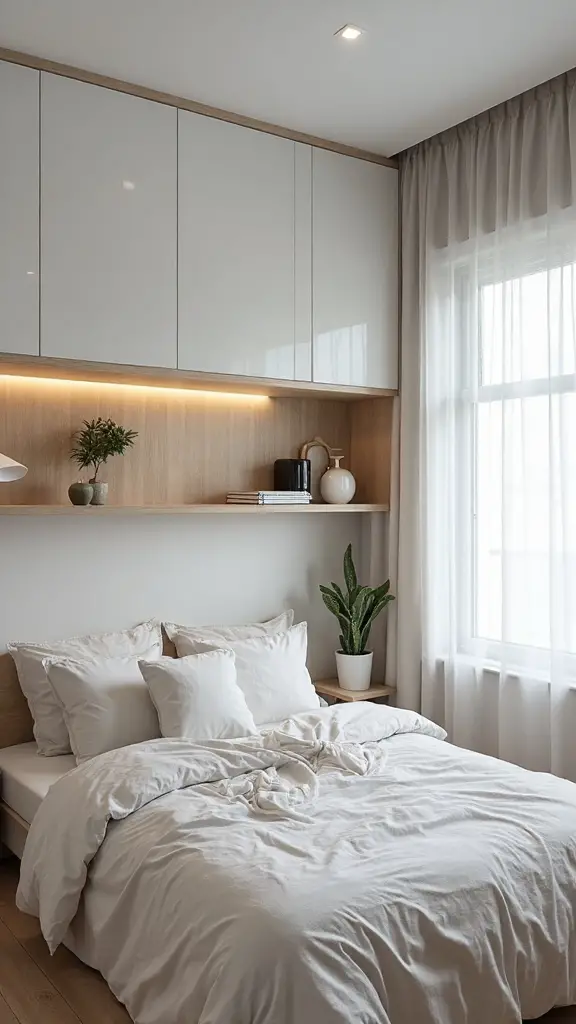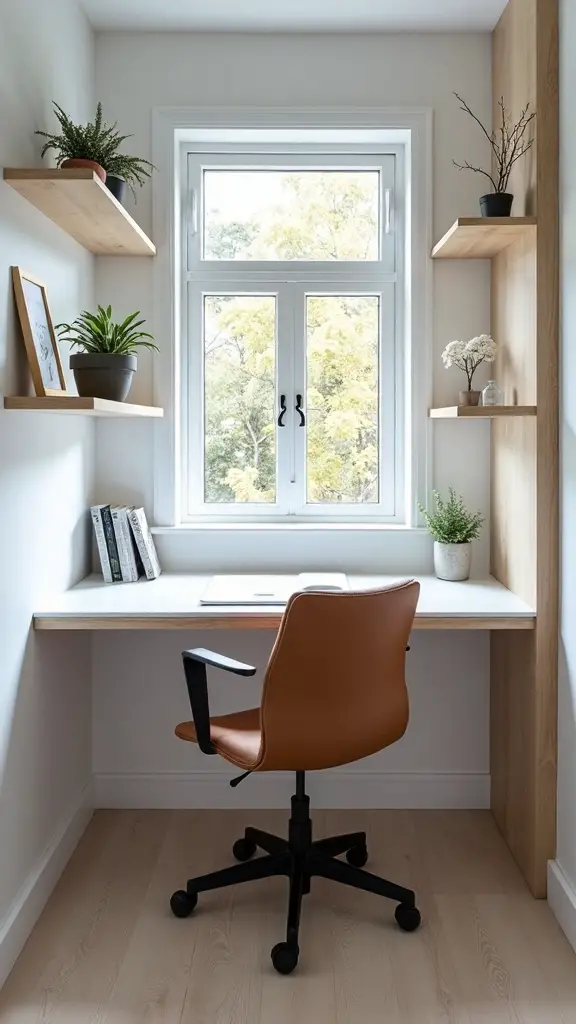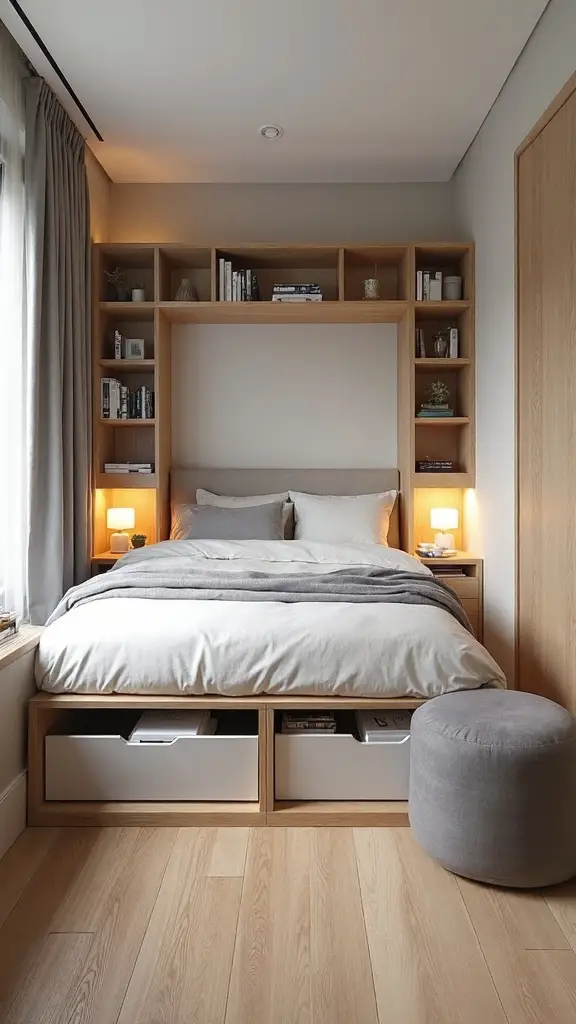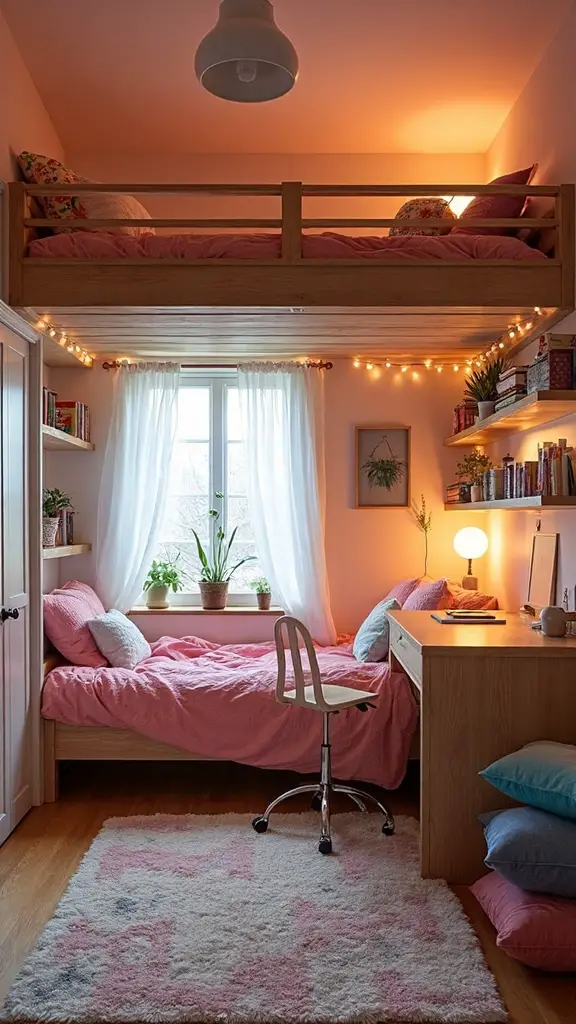18 Small Bedroom Ideas for Kids With Fun Designs
Innovative small bedroom designs transform cramped kids’ spaces into organized, imaginative havens that maximize storage while sparking creativity and growing with your child.
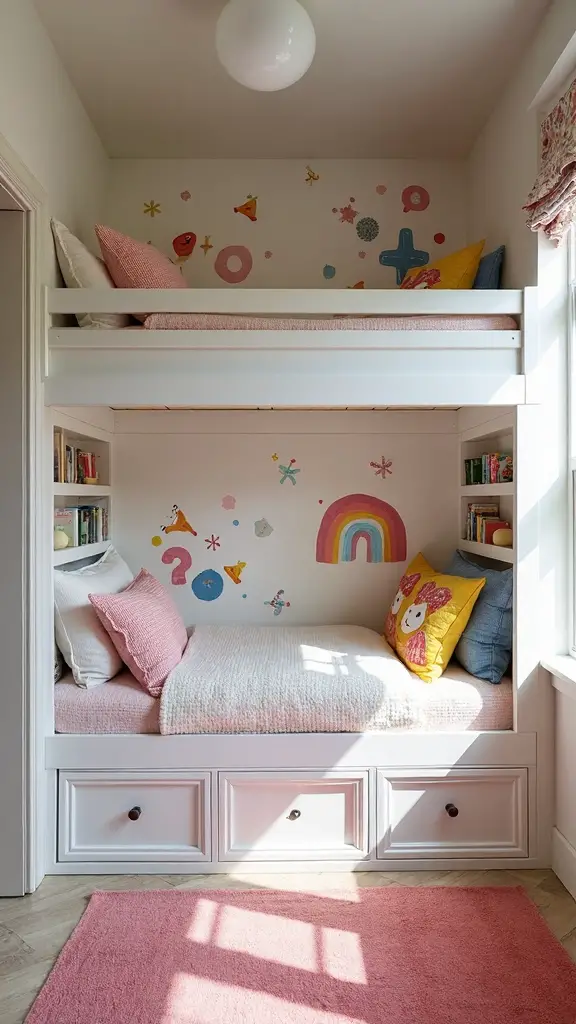
You’re facing the challenge of designing a functional yet playful bedroom in limited square footage, but small spaces don’t have to mean sacrificing style or storage. Smart design choices can alter cramped quarters into organized havens that spark your child’s imagination while keeping clutter at bay. From innovative loft configurations to clever vertical solutions, these space-maximizing strategies will help you create a room that grows with your child’s changing needs and interests.
Maximize Space With Low Loft Beds and Integrated Storage
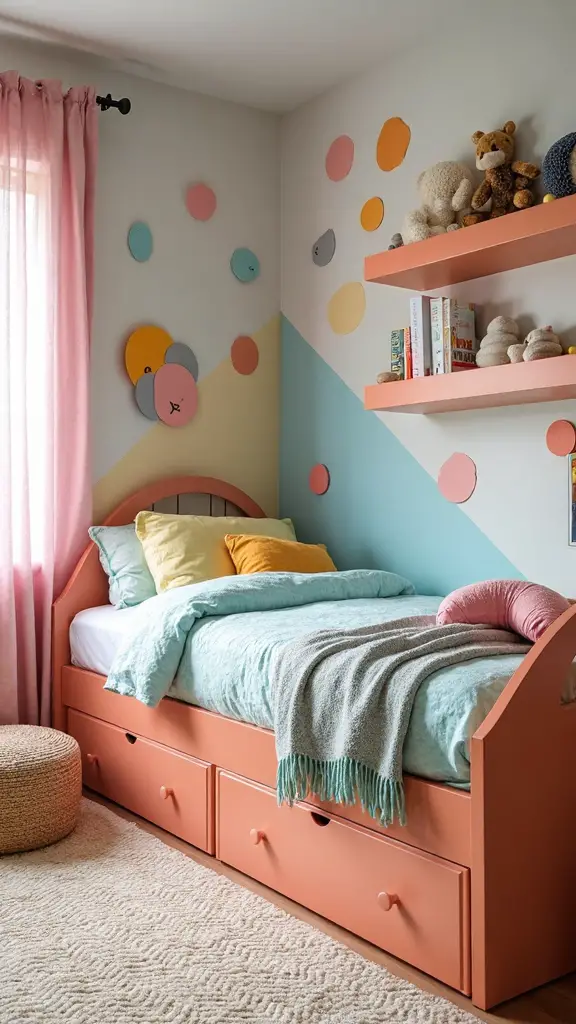
When you’re dealing with a cramped kids’ bedroom, low loft beds become your secret weapon for creating functional space without overwhelming the room. These uplifted sleeping solutions free up precious floor area underneath for essential furniture like dressers, bookcases, or homework stations.
Choose a loft bed with built-in stairs that double as drawers, giving you extra storage space while ensuring safe access. Integrated bookcases make bedtime stories convenient and keep favorite books within reach.
Consider models with slide-out desks that tuck away when homework’s finished, maximizing every square foot of your child’s bedroom.
Create a Study Haven With Built-In Desks and Bookcases
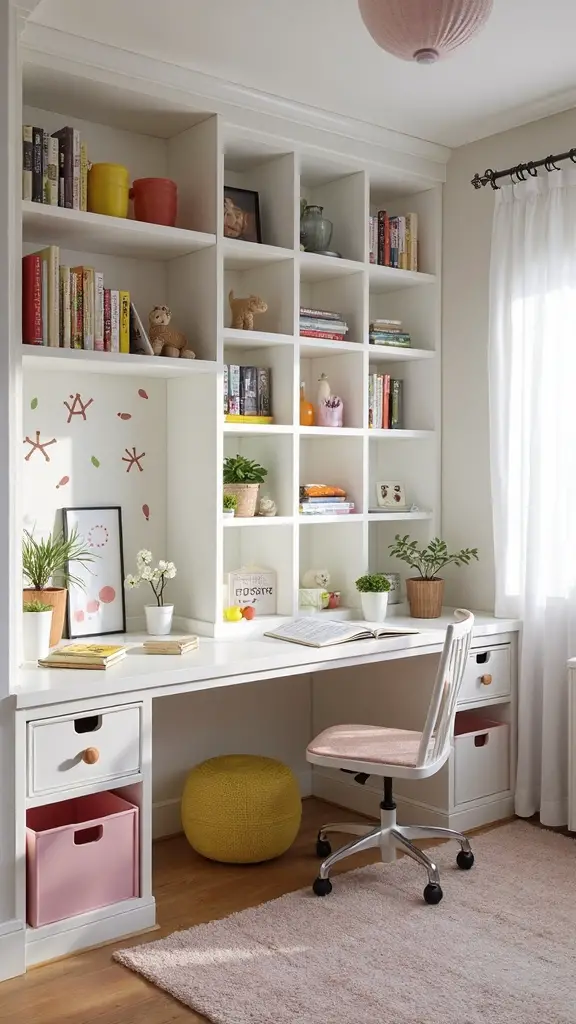
Built-in desks and bookcases convert your child’s cramped bedroom into an organized study sanctuary that grows with their academic needs. These custom solutions maximize every inch of available floor space while establishing a dedicated homework zone that encourages focused learning.
Position built-in desks beneath lofted beds to capitalize on vertical space, freeing up room for play activities. Install adjustable shelving systems within your bookcases to accommodate expanding collections of textbooks and school supplies as your child advances through different grade levels.
Don’t forget adequate task lighting—add desk lamps or wall-mounted sconces to illuminate the study area effectively.
Add Fun With Slides and Play Features
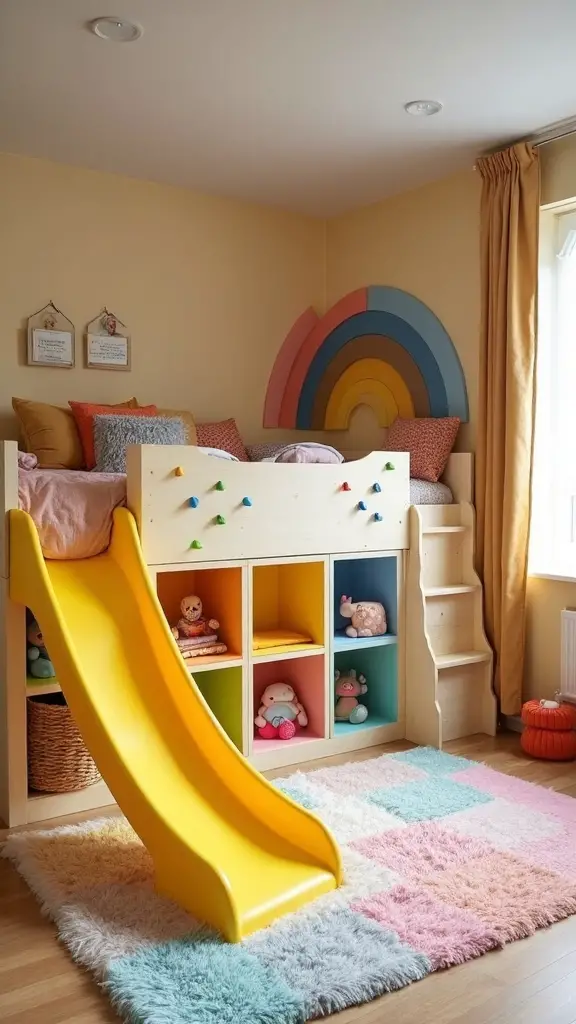
Metamorphose your child’s confined bedroom into an expedition zone by incorporating slides, climbing features, and interactive play elements that maximize vertical space while igniting creativity.
Install a slide from your bunk bed’s top level, creating an exhilarating exit route that kids absolutely love. Add rock climbing grips to walls, transforming ordinary surfaces into challenging journey paths. Design beds with tunnels or crawl spaces underneath, encouraging imaginative exploration in tight quarters.
Consider treehouse-inspired structures that blend storage solutions with study areas. These playful additions turn any small room into an indoor playground where children can climb, slide, and dream endlessly.
Utilize Corner Configurations for Multiple Kids
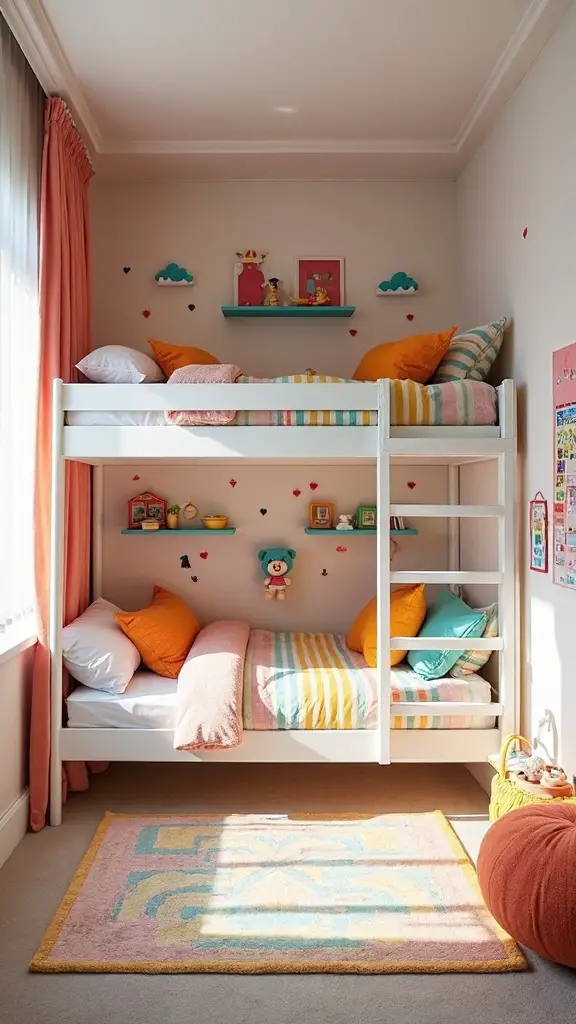
Corner loft bed configurations alter challenging room layouts into efficient sleeping solutions that give each child their own designated space. L-shaped designs create independent sleeping and study zones while maximizing your kids room’s vertical potential.
You’ll transform underutilized corners into functional areas by placing desks and dressers beneath raised beds.
Individual ladders guarantee each child accesses their personal space without disturbing siblings during bedtime routines. The versatile corner setup tailors to your childs room’s specific dimensions and needs.
You can reconfigure furniture placement as children grow, making this solution both practical and cost-effective for growing families sharing compact spaces.
Install Vertical Storage Solutions on Walls
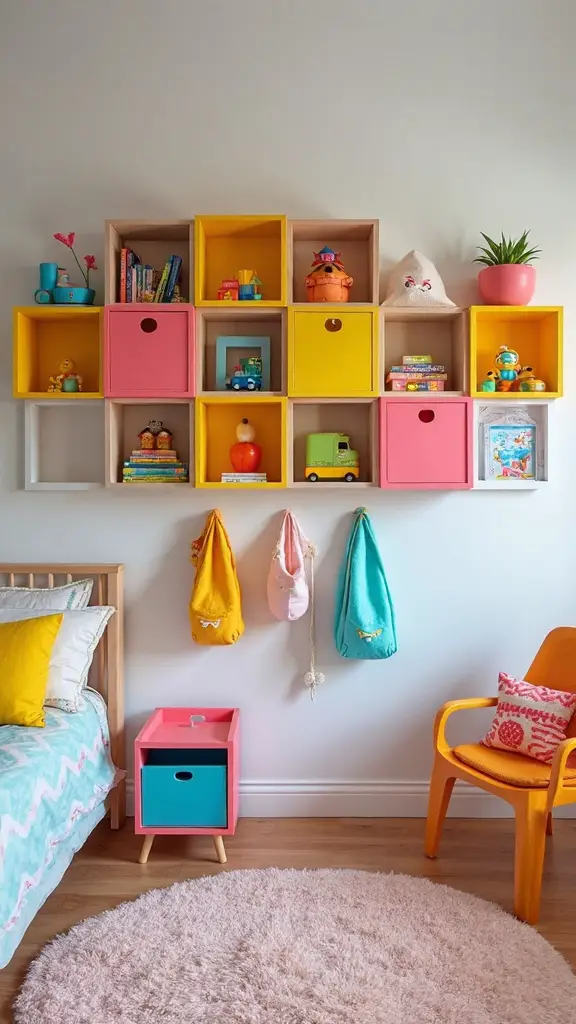
When floor space becomes precious, vertical storage solutions metamorphose your child’s walls into organized, functional areas that maximize every square inch. Floating shelves create perfect display space for books, toys, and decorative items while keeping floors completely clear.
Wall-mounted cubbies and bins provide designated spots for everything from art supplies to stuffed animals. Install pegboards with colorful hooks for backpacks, hats, and frequently used items. These creative storage ideas convert bare walls into functional zones that grow with your child’s changing needs while maintaining an uncluttered, spacious bedroom environment.
Choose Twin Beds to Free Up Floor Space
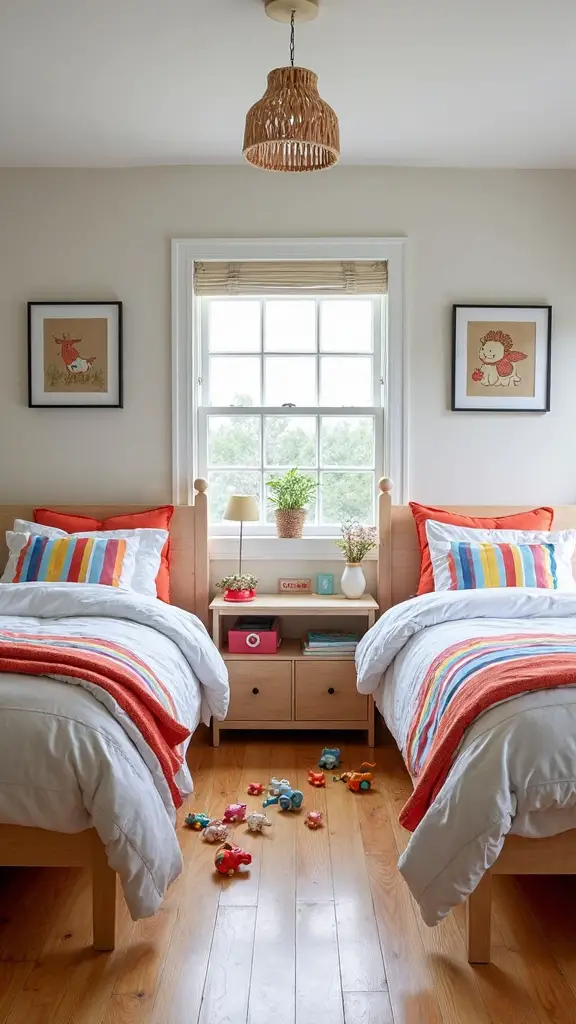
After organizing your walls efficiently, selecting the right bed size becomes your next strategic move for maximizing precious floor space. Twin beds offer the perfect solution for cramped children’s bedrooms, creating substantially more room for play areas and essential storage.
Push these compact beds into corners to further optimize your available square footage and improve traffic flow throughout the space. For families with multiple children, twin beds work exceptionally well in a shared room setup, giving each child their own personal sleeping area while maintaining an organized, functional bedroom layout that doesn’t feel overcrowded or chaotic.
Transform Under-Bed Areas Into Hidden Storage
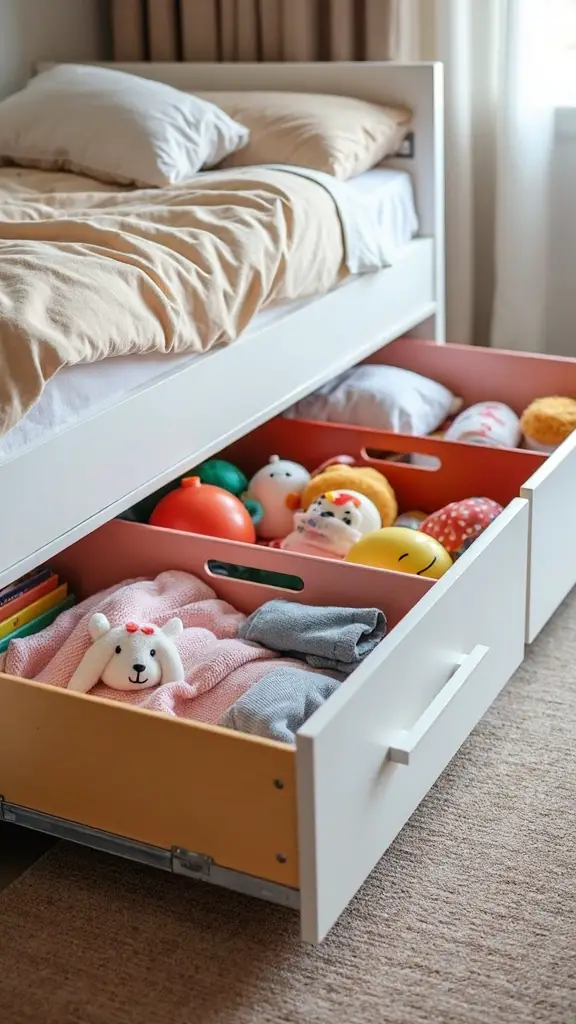
The space beneath your child’s bed represents one of the most underutilized storage goldmines in any small bedroom. You’ll maximize this area by installing wheeled containers or lidded bins that slide effortlessly for quick access.
Consider upgrading to a storage bed frame featuring built-in drawers that neatly organize clothing and toys. Large, shallow plastic bins work perfectly for stashing off-season clothes and extra linens.
Storage ottomans double as seating while providing concealed compartments. For ultimate efficiency, build a custom platform bed with integrated cubbies. These underbed storage solutions convert wasted space into organized, hidden compartments that keep your child’s room clutter-free and functional.
Design Accessible Storage Cubbies at Kid Height
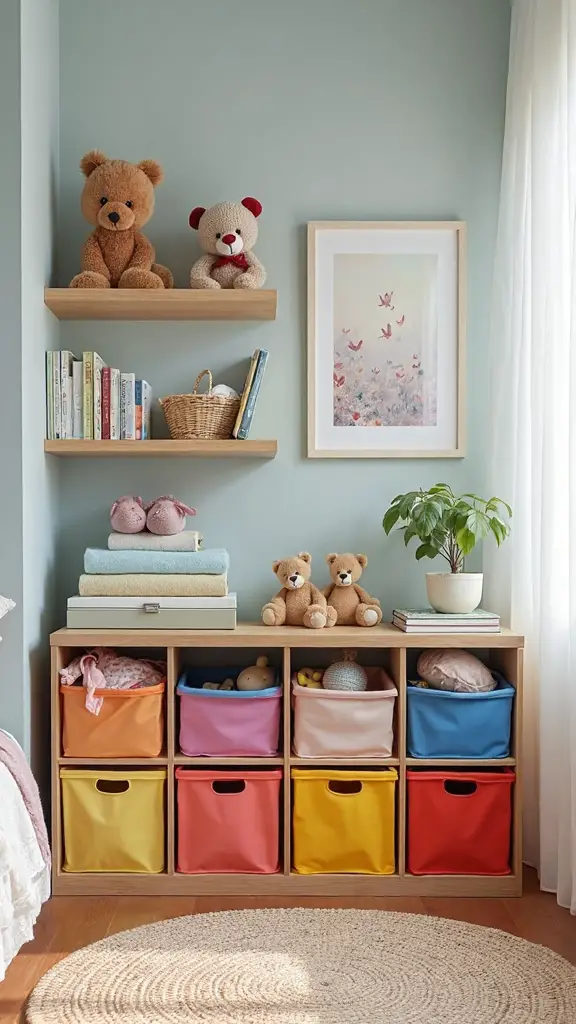
Smart storage planning puts cubbies and containers at your child’s eye level, creating an organized system they can actually use independently. Position storage cubbies near play areas and desks to keep frequently used items within easy reach. Label or color-code each storage space to help kids learn proper organization habits while making cleanup feel manageable.
Mix closed storage bins with open-front cubbies to balance accessibility and visual organization in your kids’ bedroom. This combination encourages tidy habits while preventing overwhelming clutter. Low-height placement secures children can retrieve toys, books, and belongings without assistance, promoting independence and responsibility.
Hang Clothes Instead of Using Bulky Dressers
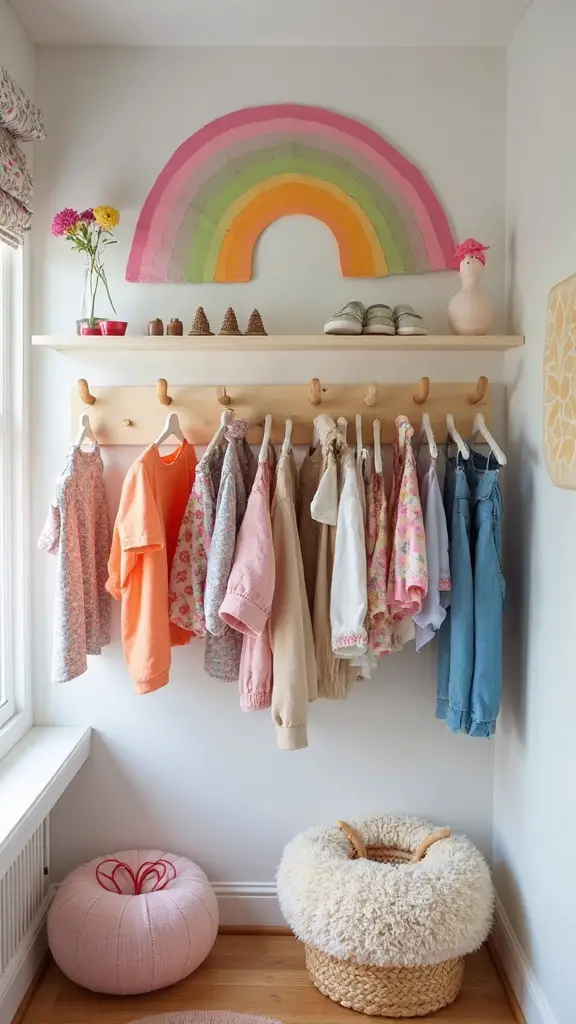
Beyond organizing at floor level, you’ll uncover that vertical storage alters your approach to clothing management in tight quarters. Wall-mounted clothing racks reshape your kids’ bedroom by eliminating bulky dressers that consume precious floor space.
These ideas create more open play areas while utilizing underused vertical wall space effectively. Install closet organizers at appropriate heights to keep children’s garments accessible and organized. You’ll find this solution particularly beneficial for kids with limited wardrobes or those who outgrow clothes quickly.
The streamlined approach allows room for essential furniture while maintaining functionality in your compact space.
Organize Accessories in Labeled Storage Bins
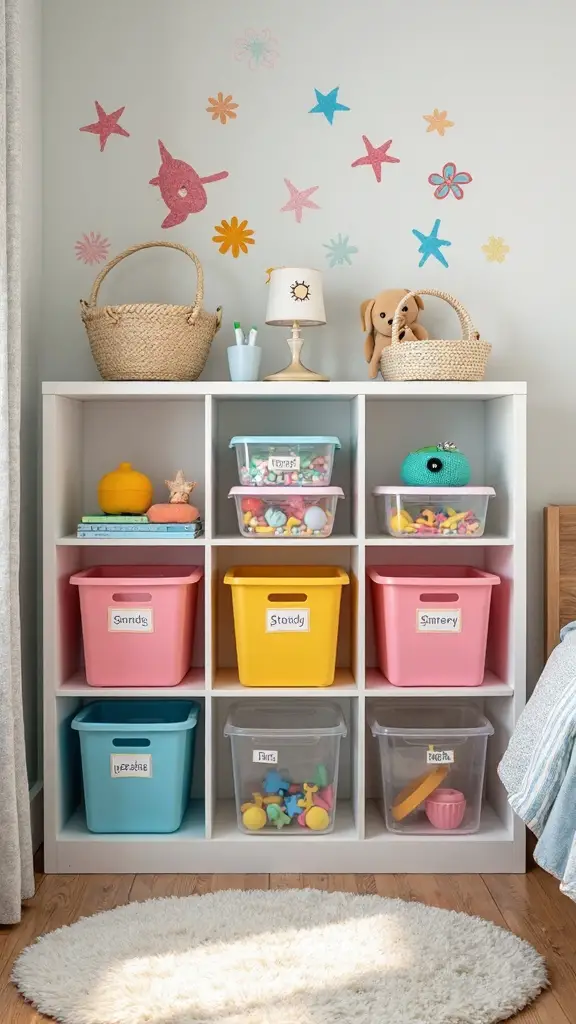
When accessories pile up in corners and overflow from drawers, labeled storage bins convert chaotic small items into an organized system. You’ll make kids bedrooms more functional by dedicating specific bins for shoes, socks, and hats. Color-coding these containers helps children learn proper organization while developing independence.
Clear labels prevent confusion and encourage consistent tidying habits. These bins maximize your limited floor space while freeing up precious closet and dresser room. Position bins at child-friendly heights for easy access. This storage solution alters scattered accessories into a neat, maintainable system that keeps small bedrooms clutter-free.
Remove Closet Doors to Open Up the Space
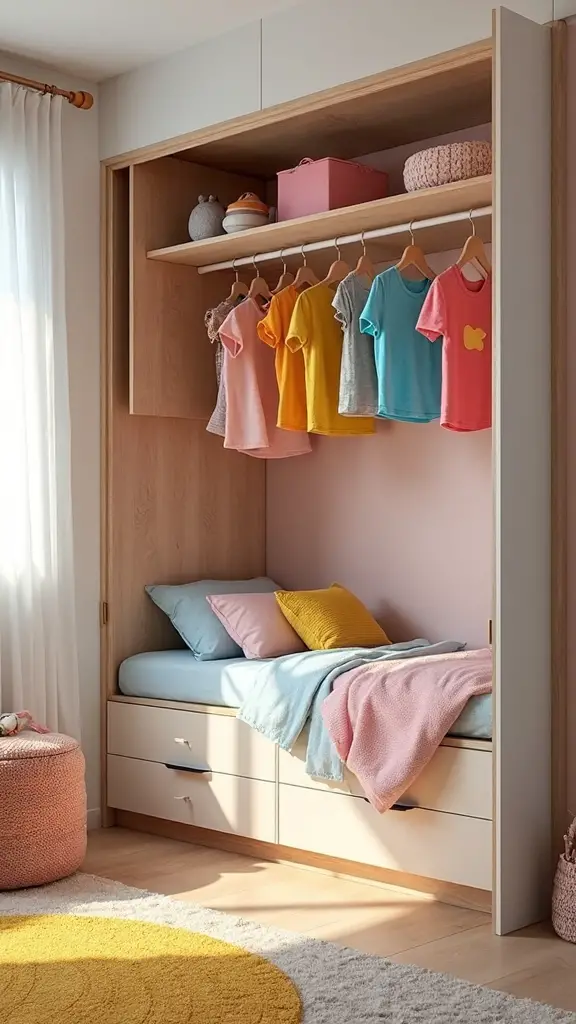
Closet doors often consume precious visual space that small bedrooms desperately need, making rooms feel cramped and confined. Removing these barriers creates an immediate illusion of expanded space while dramatically improving functionality in your kids’ bedroom.
This simple alteration eliminates the visual interruption that doors create, allowing your eye to travel unobstructed across the room. You’ll find accessing toys, clothes, and storage items becomes effortless without constantly opening and closing doors.
The open closet design works particularly well when you organize contents with labeled bins and attractive storage solutions that complement your room’s décor.
Use Light Colors to Make Rooms Feel Larger
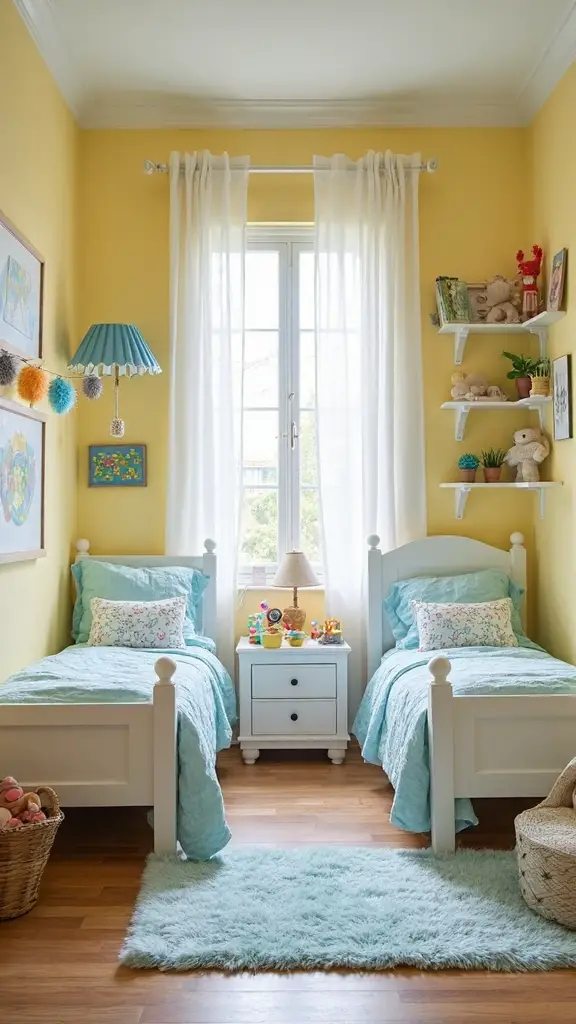
Light colors possess exceptional power to alter cramped kids’ bedrooms into seemingly spacious retreats that feel bright and welcoming. You’ll create an airy atmosphere by choosing white, beige, or light gray wall paint that reflects natural light throughout the space. These neutral hues make your child’s room appear larger while providing flexibility as they grow from toddler to teenager.
Light-colored furniture and furnishings complement pale walls, enhancing the expansive feel. You can easily update decor and accessories without repainting, making changes smoother. This strategic color choice maximizes your kids’ bedroom potential through simple yet effective design principles.
Incorporate Multifunctional Furniture Pieces
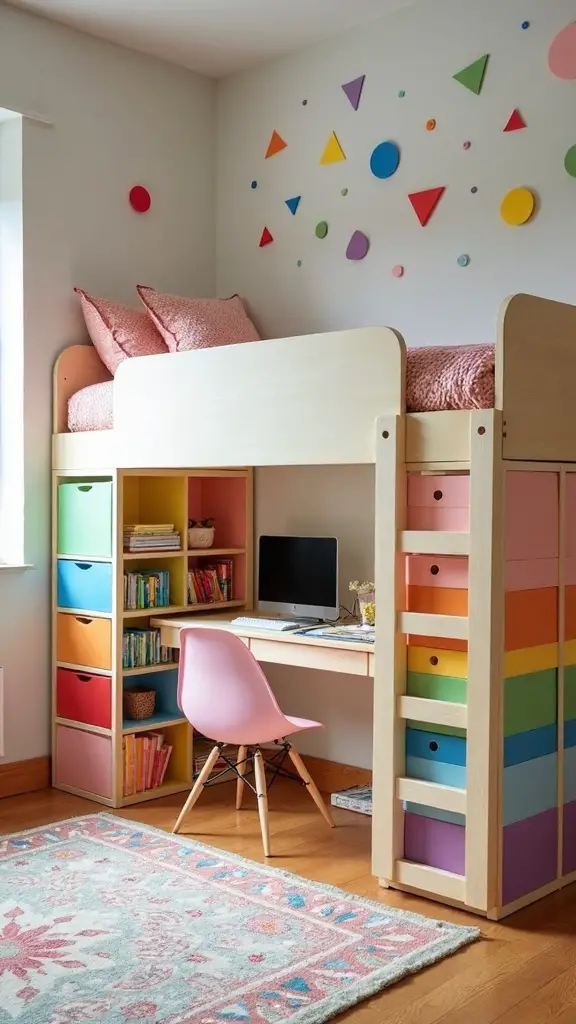
Multifunctional furniture pieces alter cramped children’s bedrooms into organized, spacious environments by serving double or triple purposes within the same footprint. You’ll maximize extra space by choosing beds with built-in storage drawers underneath for toys, books, and seasonal clothing.
Consider ottoman benches that provide seating while hiding stuffed animals inside. Desk-bed combinations offer homework areas that fold away when it’s sleep time. Wall-mounted Murphy beds create instant play areas during daytime hours. Loft beds with integrated closets underneath double your usable floor space.
These smart furniture choices eliminate clutter while maintaining functionality your child needs for sleep, study, and play activities.
Designate Play Areas With Colorful Rugs
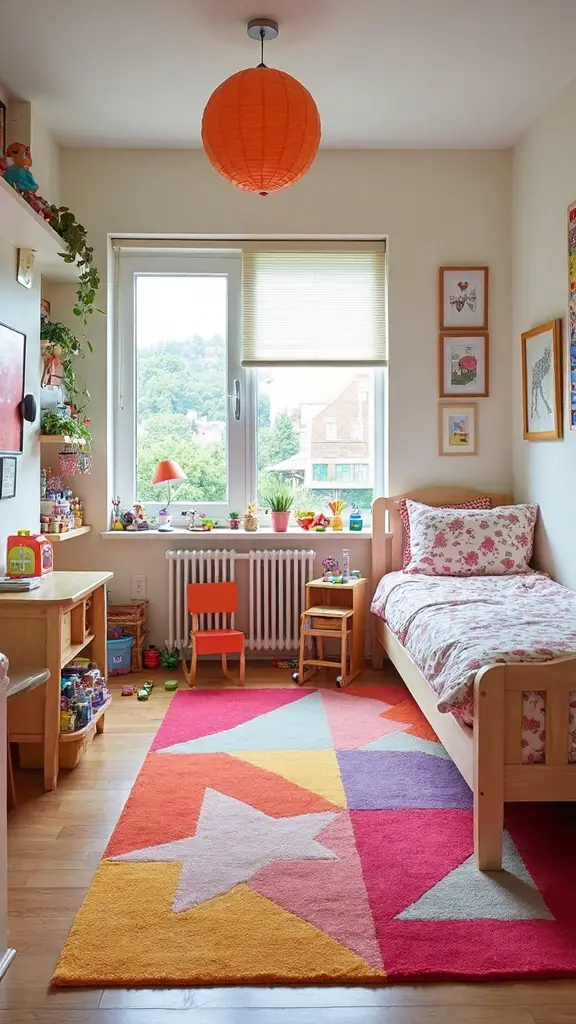
Colorful rugs alter undefined floor space into dedicated play zones while adding warmth and visual interest to your child’s small bedroom. Choose large, soft rugs that clearly define boundaries between sleeping and activity areas. Select washable, patterned options that hide stains and simplify maintenance in your kids’ bedroom.
Maximize functionality by incorporating built-in storage around the rug perimeter, such as custom wardrobes or a kids study desk. These built-in pieces adapt as your child grows and can be refreshed with new paint or hardware updates. This approach creates organized zones while maintaining the room’s overall flow.
Keep Special Items Safe on High Shelves
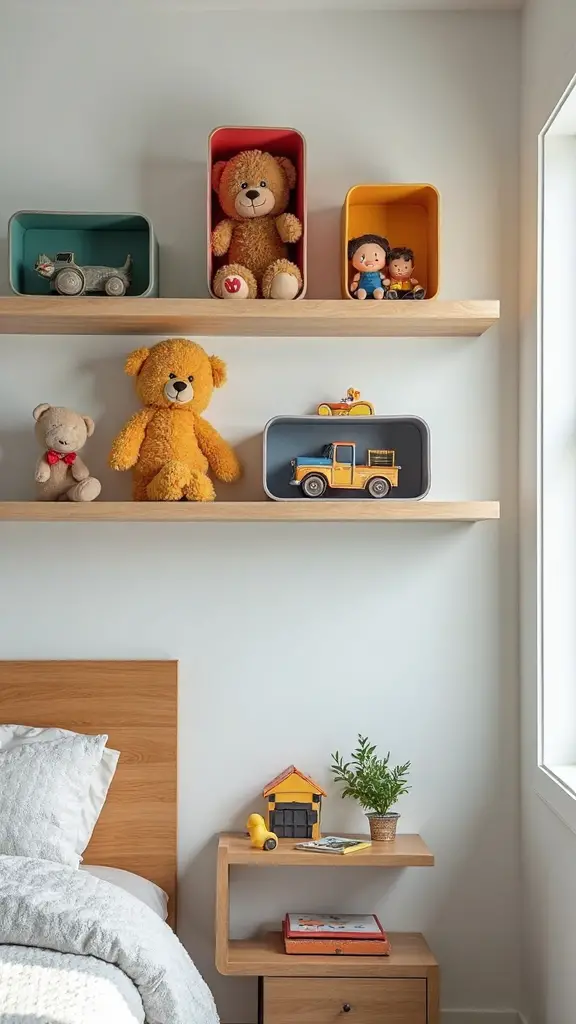
When you’re working with limited floor space, vertical storage becomes your best friend for protecting treasured belongings from damage or loss. Install floating shelves on your kids’ bedroom walls to display delicate collectibles and sentimental items safely above curious hands. You’ll create an organized display while freeing prized dresser and floor space for daily essentials.
Consider hanging a ceiling-mounted mesh hammock for storing special stuffed animals that shouldn’t face rough play. Keep fragile arts and crafts projects on high shelves where they’re visible but protected. This approach makes tidying easier while ensuring precious keepsakes remain safe from accidental damage.
Create Individual Expression Spaces in Shared Rooms
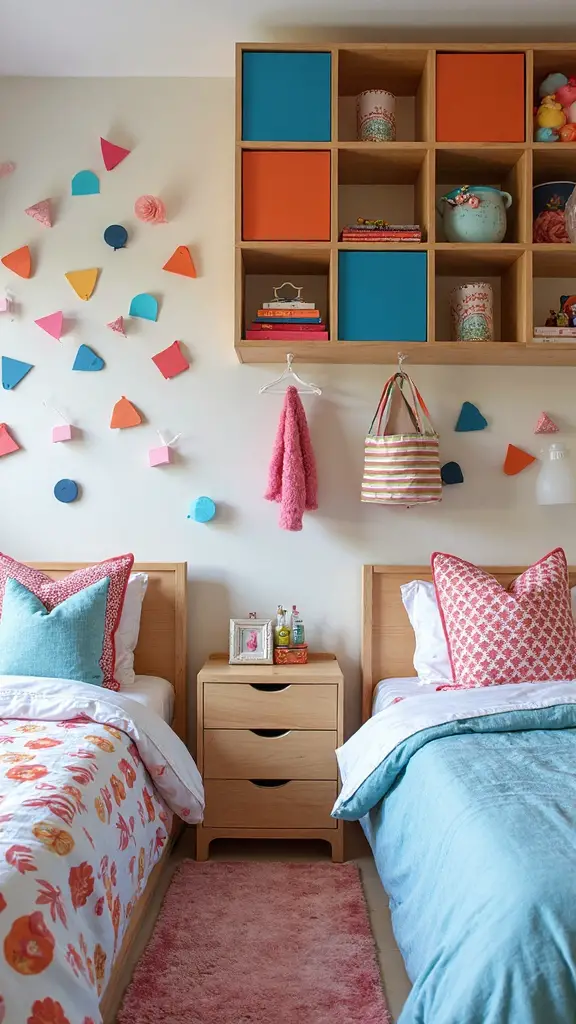
Sharing a bedroom doesn’t mean your children have to sacrifice their individual personalities or creative expression. You can create distinct zones using different color schemes, patterns, or themes that reflect each child’s preferences and make their space feel uniquely theirs.
Install separate desks, shelving units, or storage solutions where each child can display their favorite toys and personal items. Use low bookcases, decorative screens, or curtains to divide the room while maintaining openness. Encourage your children to collaborate on shared elements like lighting or rugs to achieve a cohesive look and feel throughout the space.
Design Craft and Activity Zones With Smart Storage
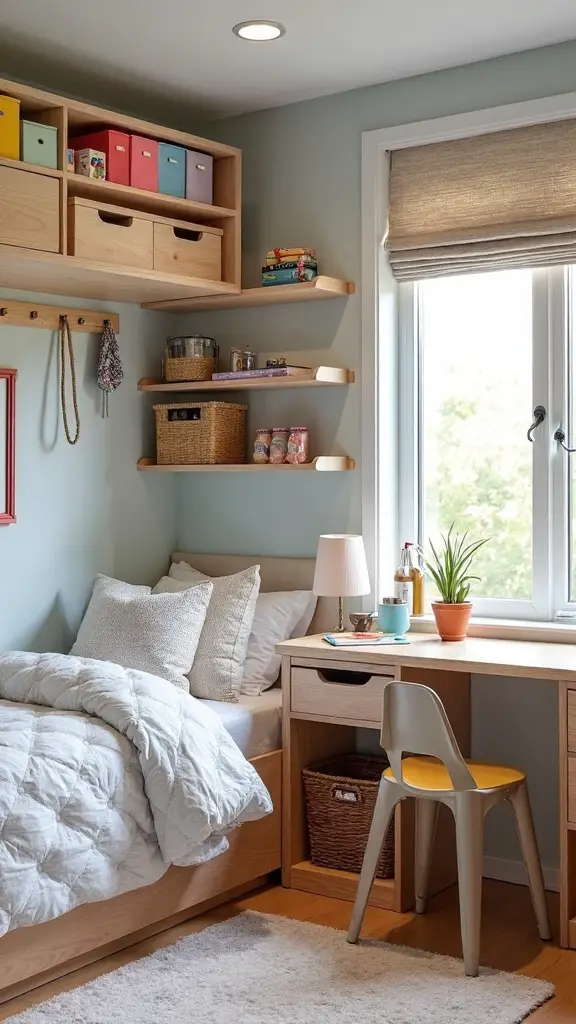
Although small bedrooms present storage challenges, you can create highly functional craft and activity zones that maximize every square inch of available space. Install wall-mounted shelves and cubbies above workstations to store art supplies within easy reach.
Choose a multipurpose table that shifts seamlessly from homework to creative projects, incorporating built-in drawers for materials. Add rolling carts for portable storage that adapts to different activities throughout the day. These creative solutions convert your kids’ bedroom into an organized hub for learning and play.
Vertical storage keeps floors clear while dedicated zones encourage independent creativity and focused work time.
Embrace Bold Patterns and Bright Color Accents
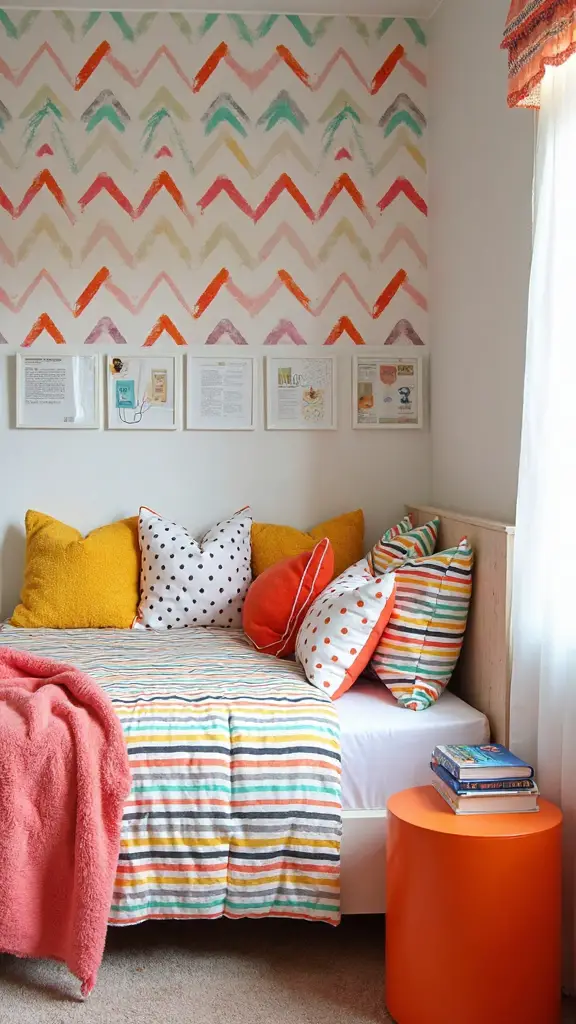
Beyond creating organized activity areas, you can reinvent your child’s small bedroom into a lively sanctuary by incorporating bold patterns and vibrant color accents that spark joy and creativity.
Transform your kids’ bedroom with energetic polka dots, rainbows, and hot air balloon motifs that create whimsical atmospheres. Design ideas include color-blocking techniques using contrasting pink and white hues on walls, instantly transforming cramped spaces.
Add travel-themed wallpaper featuring cityscapes and airplanes to inspire wanderlust. Accent light-colored furniture with bold pink and gold touches for refined elegance. Embody playful themes showcasing favorite toys like cars, dinosaurs, and jungle animals.
Conclusion
You’ve uncovered numerous ways to metamorphose your child’s small bedroom into a functional, exciting space. These smart design solutions maximize every square foot while creating room for sleep, study, play, and storage. By implementing loft beds, vertical storage, activity zones, and personalized touches, you’ll craft an environment that grows with your child. Start with one or two ideas that fit your space and budget, then expand as needed.
